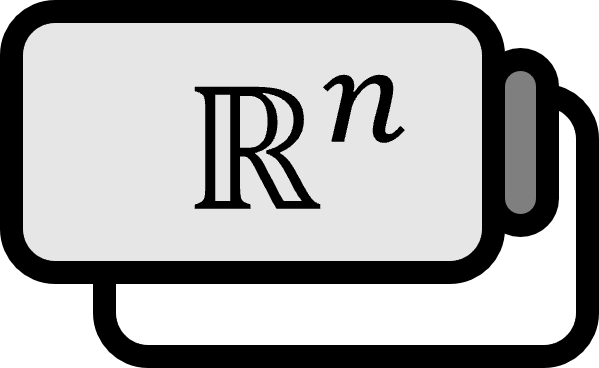Jacobian Matrix or Jacobi Matrix
Definition
Let a multivariable vector function $\mathbf{f} : D \to \mathbb{R}^{m}$ defined by $D \subset \mathbb{R}^{n}$ be defined for each scalar function $f_{1} , \cdots , f_{m} : D \to \mathbb{R}$ as follows:
$$ \mathbf{f} ( x_{1} , \cdots , x_{n} ) : = \begin{bmatrix} f_{1} ( x_{1} , \cdots , x_{n} ) \\ \vdots \\ f_{m} ( x_{1} , \cdots , x_{n} ) \end{bmatrix} $$
It is called the Jacobian matrix of $\mathbf{f}$.
Description
The following notation is also often used:
$$ J = \dfrac{\partial (f_{1}, \dots f_{m})}{\partial (x_{1}, \dots, x_{n})} $$
The Jacobian matrix of $\mathbf{f}$ is also represented by defining an operator $D$ that makes $D \mathbf{f} := J$. The name Jacobian matrix comes from the 19th-century German mathematician Carl Gustav Jacob Jacobi, so it’s correct to write and read it as Jacobian matrix, but in fact, $J$ is very often read as ‘Jacobian’.
It is also called the total derivative, referring to the derivative of a multivariable vector function. Therefore, if a Jacobian matrix exists for a multivariable function, it is said to be differentiable, and conversely, a differentiable function $f : \mathbb{R} \to \mathbb{R}$ can be thought of as having a Jacobian matrix of size $1 \times 1$. In simple terms, the Jacobian matrix is the matrix of the derivative of a vector function.
Typically, it is first encountered in calculus together with polar coordinates, where
$$ \int_{B} \int_{A} f(x,y) dx dy $$
if you change the Cartesian coordinates used to $x= r \cos \theta$, $y= r \sin \theta$ as well known,
$$ \int_{B} \int_{A} f( r \cos \theta , r \sin \theta ) r dr d \theta $$
an additional $r$ is attached as follows. This is because
$$ \begin{bmatrix} {{\partial x } \over {\partial r }} & {{\partial x } \over {\partial \theta }} \\ {{\partial y } \over {\partial r }} & {{\partial y } \over {\partial \theta }} \end{bmatrix} = \begin{bmatrix} \cos \theta & \sin \theta \\ -r \sin \theta & r \cos \theta \end{bmatrix} $$
the determinant of the matrix is derived as $r \cos^2 \theta + r \sin^2 \theta = r$. In the same sense, the Jacobian matrix is essentially the same concept already encountered in high school when doing variable substitution for integration. For example,
$$ \int_{0}^{1} ( 27x^3 + 9 x^2 + 3 x ) dx $$
consider doing the substitution like $3x = y$ when calculating. If this is viewed as $y$ being the function $y(x) = 3x$ of $x$, then its Jacobian matrix is
$$ \begin{bmatrix} {{\partial 3x } \over {\partial x }} \end{bmatrix} = \begin{bmatrix} 3 \end{bmatrix} $$
This is the same as differentiating both sides of $3x = y$ with respect to their variables to obtain $3dx = dy$.
